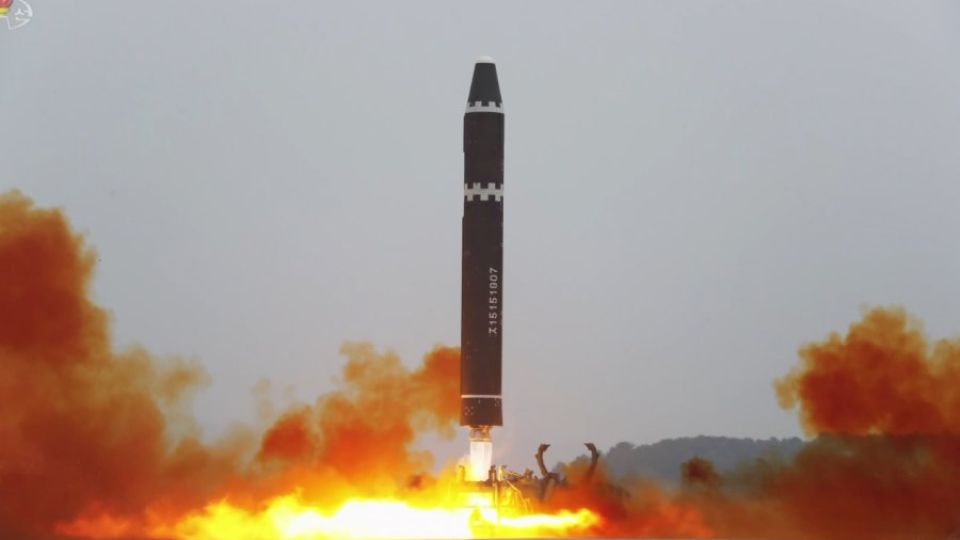February 20, 2023
SEOUL – South Korea and the US staged combined air drills Sunday, a day after North Korea aggravated inter-Korean tensions by firing an intercontinental ballistic missile that South Korea believes could reach anywhere in the continental United States.
The launch came ahead of the first Seoul-Washington nuclear drills scheduled for this week and their annual field exercises for next month — both of which are intended to help deal with Pyongyang’s nuclear ambitions.
The Hwasong-15 launch, the first ICBM firing since November last year when the North’s most advanced Hwasong-17 was revealed, demonstrated a “fatal nuclear counterattack” amid “relentless efforts” for a bigger nuclear arsenal, the official Korean Central News Agency said.
The missile fell into waters west of Japan as it was intentionally fired at a steep angle to avoid flying over the island toward the Pacific Ocean, a pattern for every other ICBMs the North has tested so far.
“The dangerous military preparations by South Korea and the US in the name of joint military readiness are destroying stability in the region and raising stakes,” Kim Yo-jong, the powerful sister of leader Kim Jong-un, said in a statement released by the North’s Foreign Ministry on Sunday morning.
In response to the launch, South Korea and the US flew their fighter jets in a show of force, with Washington fielding B-1B strategic bombers from its mainland to reaffirm its commitment to extended deterrence. The US promises to use all resources including nuclear weapons to deter and respond to attacks on its allies.
The two allies will start mapping out concrete steps aimed at translating such firepower into step-by-step action at a Pentagon meeting Wednesday, where they will discuss contingencies while simulating a North Korean nuclear attack. The first tabletop drill — agreed by the two defense chiefs last year amid growing skepticism asking the US to be more specific about its commitment — will be followed by their joint field maneuvers in mid-March.
Pyongyang, which describes such large-scale drills involving troops as “rehearsals for invasion,” has repeatedly called for suspending them, a demand that matched Washington’s understanding in August 2018, two months after the first historic summit between the US and North Korea. Then, former President Donald Trump discussed halting the drills to give priority to diplomacy.
But little progress on Pyongyang’s disarmament has been made since then. Along with leadership changes in Seoul and Washington, the lack of headway has prompted a return to all-out exercises. President Yoon Suk Yeol and his US counterpart, Joe Biden, has vowed to bolster their defenses unless North Korean leader Kim Jong-un shows he is serious about living up to denuclearizing his country.
In statements, the offices of Yoon and Biden strongly condemned Saturday’s missile firing, saying it violated UN Security Council resolutions. The US recently sought a UNSC presidential statement to deter North Korea’s aggression, an attempt apparently blocked by China and Russia. Those efforts led by “America’s unilateralism” would yield “no outcome” North Korea said of international intervention, stressing it is unfairly targeted.
Park Won-gon, a professor of North Korean Studies at Ewha Woman University, said Pyongyang was laying groundwork for further provocations, referring to the Seoul-Washington field exercises and UN checks on North Korea as reasons for the isolated country to stay aggressive.
“The line of provocations we have to expect for 2023 is quite different from 2022, in that from now on, South Korea and the US will be the subjects of North Korea’s hostility. Kim Yo-jong just showed the two allies would be the ones facing threats if they don’t behave,” Park said.
But the focus of those provocations, Park added, would be more on Washington rather than Seoul as Pyongyang tries to show off its missile technologies so the US feels threatened enough to reverse its policy. “Plus we still can’t rule out another nuclear test,” Park said, referring to the last time that happened in 2017.
Meanwhile, Foreign Minister Park Jin said over the weekend that another nuclear test would be a “game changer” for North Korea, without elaborating. He and his US and Japanese counterparts all urged the regime to return to nuclear dialogue, at the Munich Security Conference, a three-day gathering of experts on security policy that started Friday.


